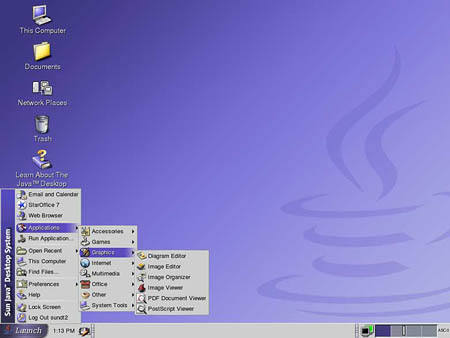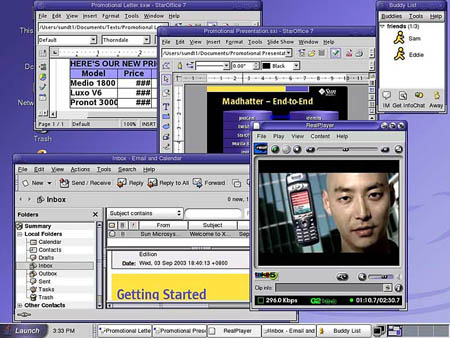Sun's W2100z Dual Opteron Workstation
by Kristopher Kubicki on October 27, 2004 12:05 AM EST- Posted in
- Systems
Sun Java Desktop System 2.0, SuSE Linux
By default, our w2100z does not come with any operating system. The Sun Java Desktop System would be the logical desktop for most to run on a Sun hardware platform. JDS is not exactly an operating system, but actually an alternative X desktop/environment to KDE or Gnome. You can check out more information about JDS here.Some JDS 2.0 applications are fairly dated, but that doesn't particularly mean that JDS is any less powerful. JDS revolves around Sun's StarOffice 7 suite on top of a modified GNOME desktop. RealPlayer, VNC, GAIM, Mozilla and Evolution are also integrated into JDS as well.
The similarities between the SuSE desktop and the JDS are very prevalent. We see the same YAST software manager and YOU online update - the only difference between YOU updates from a Sun repository instead of a SuSE one.
Sun also bundled the Looking Glass Project with our JDS desktop. Although just barely useable at this point, Looking Glass aims to be one of the first "true" 3-Dimensional desktops. Looking Glass feels a lot like the MacOS X desktop, allowing us to page through applications via a graphical list of icons in the middle of the screen. Of course, being Sun, there is a heavy dependence on Java and the only real applications that give us any additional features in Looking Glass are Java based. We will look more into Looking Glass as it evolves, but in the meantime, feel free to download the demos of the desktop from Sun's project page and the Java.net development page.
JDS's competitive edge over some other distributions mostly lays in its design, Sun designed JDS as an enterprise operating system and thus, workstation stability is paramount. Falling under Sun's corporate support wing is a plus, and the pricing certainly isn't bad either. JDS's nearest competitor, Ximian XD2, offers the OpenOffice suite instead of StarOffice, but costs $100 for full support.
JDS is still in its infancy. The fact that JDS does not support 64-bit Linux operation is disappointing, but it is not its downfall. In fact, for those who want a quick, simple desktop designed around StarOffice 7 (which usually costs $80 by itself), JDS is a very neat solution. Getting Sun's tech support resources for $50/year is a great deal for many users, but it comes free with our w2100z.












47 Comments
View All Comments
t - Thursday, October 28, 2004 - link
oh... i better clarify before i get labelled as a 'zealot' or a 'mac hater' or a 'pc lover'by 'cache starved' i mean that the power4 is _very_ dependent upon its cache architecture, take some of that away and u of course impact performance... a power4 and a G5 at the same clockspeed, the power4 wins. The G5 is still an impressive chip.
t.
t - Thursday, October 28, 2004 - link
heh...this thread is hilarious...can u ppl like talk past each other some more?please :)
G5 = cut down, somewhat cache starved power4
Blue Gene/L = power4+
they are a fair bit different: l3, l2, altivec, dual v. single core...just for a couple.
gromm - Wednesday, October 27, 2004 - link
"and I'm sure that there's nothing special about the way the G5's were linked... "Actually, they have a communication network based on InfiniBand, which isn't something that you'd buy for home (especially considering how much it costs). The cards themselves are $200+ each (in quantities of 10,000 for the only price I could find for their HCA cards) and I can't even find how much the switches cost (I'm sure several thousand dollars each).
Reflex - Wednesday, October 27, 2004 - link
Thanks for the correction, its been a while since I read up on that stuff. However you still illustrated my point that this is pretty much an irrelevant benchmark for general purpose computing. People do not simply use thier PC's for floating point performance...slashbinslashbash - Wednesday, October 27, 2004 - link
Reflex: "First off, once again, you are misunderstanding what you are looking at. Total number of CPU's is only part of the equation. There are *many* factors that go into the 'most powerful supercomputer' equation. How much memory and what type/speed? How are they linking the individual nodes? What kind of software optimizations have been done, and what software is being used to benchmark it?"Wrong. The top supercomputers are rated solely by FLOPS (Floating Point Operations Per Second, as I'm sure you know) as measured by the Linpack benchmark. See www.top500.org. I've never heard of memory having an impact on FLOPS; I guess it *could* if you absolutely starved the CPUs of work, but presumably all of these computers are balanced enough that the RAM can keep up with the CPUs. The nodes can be linked in any way; presumably they're linked optimally for price/performance, and I'm sure that there's nothing special about the way the G5's were linked... you don't build a supercomputing cluster and let the linking drag the performance down. As for the optimization question, I'm not sure but I'll bet Linpack is optimized for every platform/architecture.
Reflex - Wednesday, October 27, 2004 - link
I have not been arguing about superiority for the PC platform. My point is that they are not directly comparable as related to this particuliar review. The product being reviewed does not have an equivilent on the Mac side of things, so going on about how this article proves that the 'price' arguement is wrong is rediculous.My original question has not been answered, and that is that I am wondering who is building these since I have an identical workstation here on my lab bench but with an IBM label on it.
karlreading - Wednesday, October 27, 2004 - link
enuff of the mac vs. pc B$ dudes!!!this is a comments section about a opteron workstation, not about how a g5 spanks / get spanked by opterons ass.
that said there is one part of this that gets me excited. Whilst coming across mac / pc arguments on forums, i have noticed one trend. AMD is now always the PC's defender. i never hear anybody citing the p4 / xeon as a mac comparison. its always opteron / a64 vs. g5. this is excellent news from AMD's standpoint, as it cements the trend that AMD is a respectable company, and also is impressive to see AMD as the lead PC saviour in the ongoing annoying "my pc's better than your mac " debate. Intel should be worried, very very worried. never thaught id see the day when my beloved AMD were championing the pc / x86 cause :)
gromm - Wednesday, October 27, 2004 - link
As far as cost, I'd like to see how much Apple (and other sponsors) subsidized X. The networking infrastructure it has alone would normally be massively expensive and I can't see how it fits into the $10M pricetag quoted by them along with all compute hardware.From benchmarks I have run, the G5 and the Athlon64 are neck-to-neck in performance (actually the difference is small enough to be noise) in 'normal' codes (mostly FPU) and the Athlons are a little faster in integer performance. I haven't seen what Altivec/SSE2 optimizations would do for either.
If you want some rough estimates, go to Ars Technica and look in the Battlefront forum under the Cinebench thread. There are lots of scores under there to compare for this benchmark (includes a raytracer and some other stuff).
michael2k - Wednesday, October 27, 2004 - link
I'd like to see Anand run SpecViewPerf on his Dual G5, now :)Reflex - Wednesday, October 27, 2004 - link
I am aware of Apple's 'server' aspirations. That does not change anything at all. They do not have the kind of corporate support Sun or other large venders provide, and as a result the Xserve is not a large player in the market. Furthermore, its only proof that your comparing the wrong product to the Sun product this review was about. Xserve was designed to compete with workstations like this, not the PowerMac which is a desktop system.My comment about Sun relates to the fact that for a long time they were a detriment to the industry at a whole, pushing concepts like Java PC's with no local storage, trying to keep prices very high, and generally siding with 'Big Iron' in the market rather than embracing the future. In the past year, as Microsoft/Intel/AMD have made the Sparc obsolete they have had to get with the program, choosing AMD as their partner made perfect sense as they had no motivation to improve Intel's position considering they are still competing with them in some markets.
In summation, Sun is finally seeing the light, however their past is one of high prices, legal shennanigans(especially in Europe where price fixing has been a common charge against them), and a strategy of defining themselves as Microsoft/Intel's opposition rather than charging their own course. The future will tell where they go, and I'll cross my fingers and hope that x86 Solaris and Opteron workstations are a sign that they are finally producing products their customers demand, rather than locking them into a model and then telling them what they need...